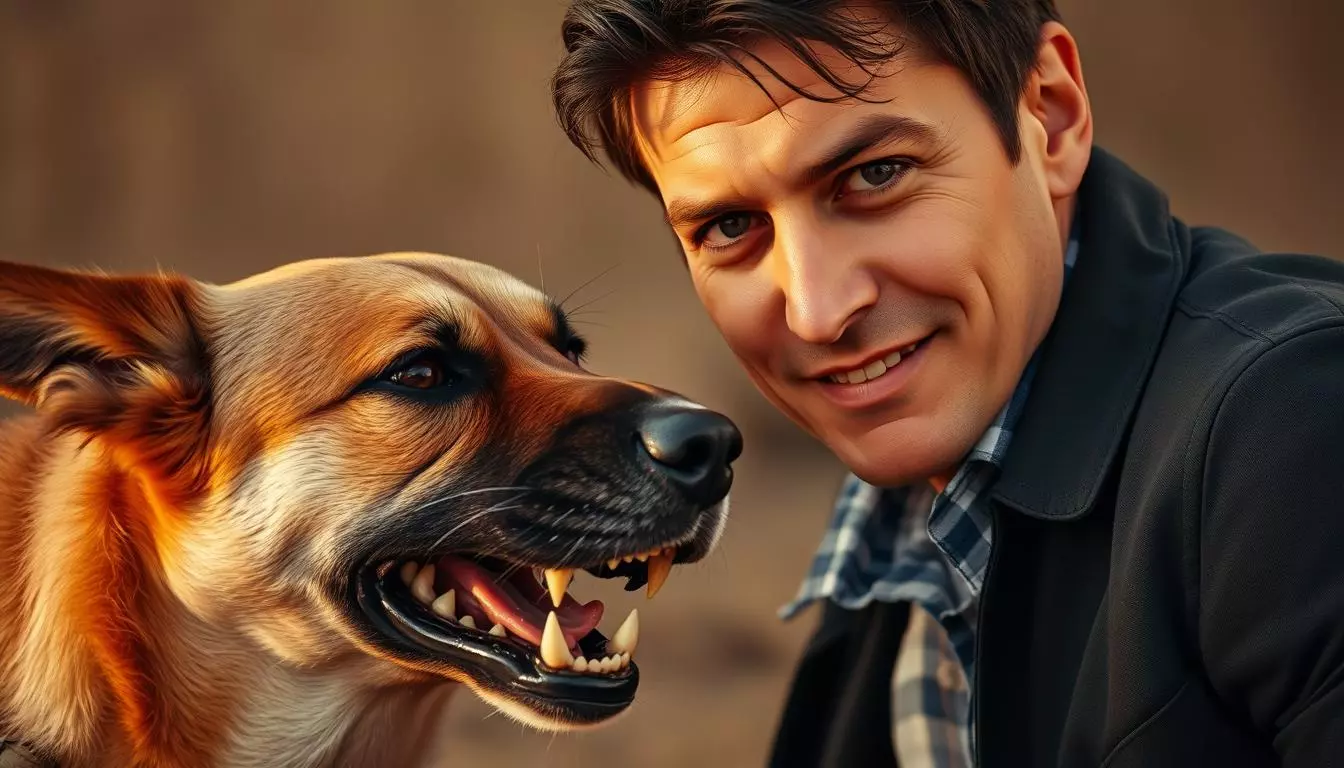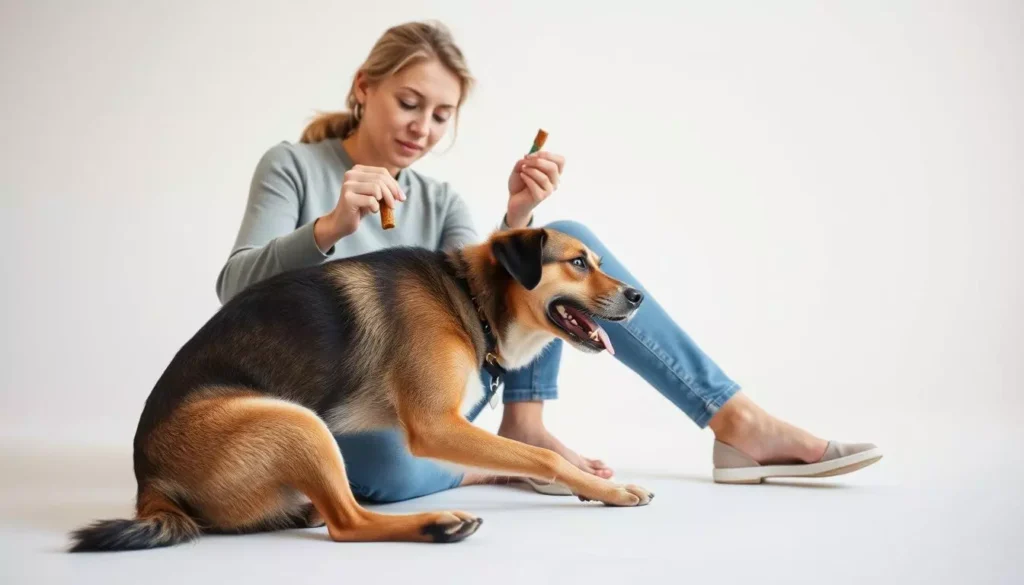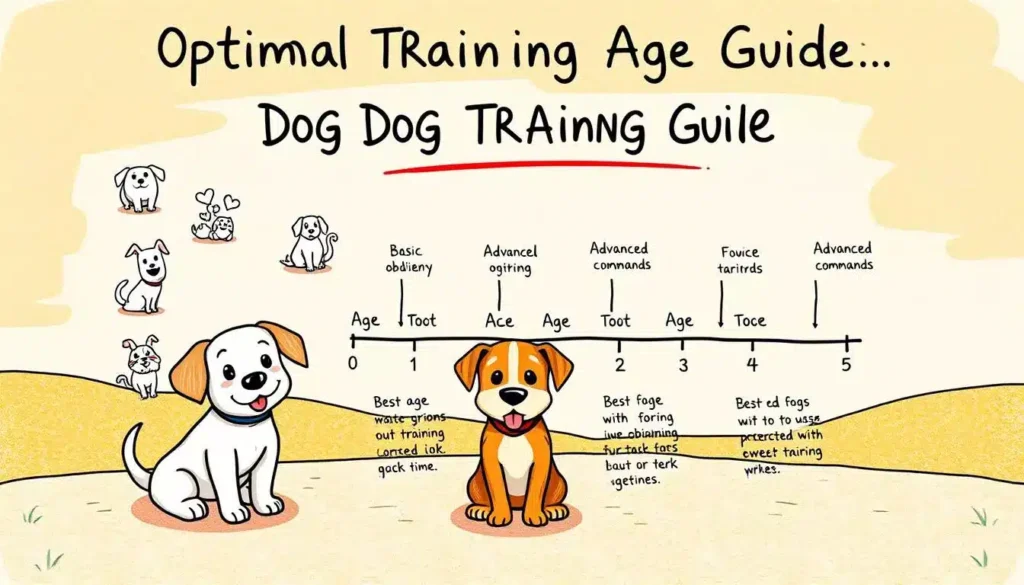Owning a dog can be incredibly rewarding, but it also comes with challenges. I remember the first time my Labrador, Max, growled at a neighbor. It was during a routine walk, and my heart raced. I realized I was dealing with something unexpected.
Dealing with aggressive dogs can feel overwhelming. But, understanding the issues and using effective strategies can help. This article aims to help you understand dog aggression. It will show you how to recognize signs and triggers and provide practical training tips.
Key Takeaways
- Understanding the signs of aggression is crucial for safety.
- Identifying the causes of aggressive behavior can help in managing it.
- Training aggressive dogs requires patience and consistency.
- Recognizing when to seek professional help is essential.
- Creating a safe environment can prevent aggressive responses.
- Positive reinforcement is a vital part of effective dog training.
Understanding Dog Aggression
Understanding dog aggression means looking at many factors. It can show up in different ways, like fear, protectiveness, or defending territory. As a dog owner, knowing these reasons helps me manage my dog's aggressive behavior.
First, it's key to know why dogs act aggressively. Some dogs might be scared or not socialized well. Others might act out because of instinct. For example, a dog might defend its territory or food.
Aggressive behavior can be mild, like growling, or serious, like biting. Knowing about dog aggression helps me train my dog better. It also keeps everyone safe. Fixing these issues early is important, as it can greatly improve my dog's behavior.
The Signs of Dog Aggression
It's important for pet owners to know the signs of dog aggression. Understanding these signs can help avoid dangerous situations. Signs include a stiff body, growling, and lunging. These show distress or defense in aggressive dogs.
Watch for snapping or barking too. These can quickly get worse if not stopped. Also, look for lip licking, yawning, and raised fur. These are signs of discomfort or anxiety in dogs.
Knowing these warning signs helps me understand my dog's feelings. It lets me take steps to keep us both safe. Recognizing these signs is key to a happy and safe relationship with our dogs.
Common Causes of Aggressive Behavior in Dogs
Aggressive behavior in dogs can stem from many factors. It's key to understand why dogs act aggressively. Fear, territorial instincts, and guarding resources are common reasons. For example, fear can make dogs aggressive when they face new situations, people, or animals.
Territorial aggression happens when dogs want to protect their home or family. They may act aggressively towards anyone or anything seen as a threat. Knowing what triggers aggression in dogs is crucial. Some dogs get aggressive with new pets, while others react to certain people.
Resource guarding is another reason for aggression. Dogs may guard food, toys, or even their owners. Knowing the cause helps us teach them better behavior. By tackling the root of aggression, we can lessen anxiety and aggression in dogs.
Types of Dog Aggression
Knowing about different dog aggression types is key for dog owners. Each type has its own reasons and signs. This knowledge helps in training and managing dogs better. Here are some common aggression types in dogs.
Territorial Aggression
Territorial aggression happens when a dog defends its home. It might bark or show aggressive signs. Dogs with this type often feel scared by strangers or visitors.
Protective Aggression
Protective aggression is when a dog guards its family or friends. It can show up in new situations or when it feels its loved ones are in danger.
Possessive Aggression
Possessive aggression is when dogs guard things they value, like food or toys. This can lead to fights, especially in homes with more than one dog.
Fear Aggression
Fear aggression is a defensive reaction to feeling trapped or scared. Dogs with this type might attack to protect themselves when they feel cornered.
Defensive Aggression
Defensive aggression is triggered by a perceived threat. Dogs may growl or snap when they feel threatened and can't escape.
Social Aggression
Social aggression is a dog's reaction to competition in its group. It can happen during play or when dogs fight over dominance or resources.
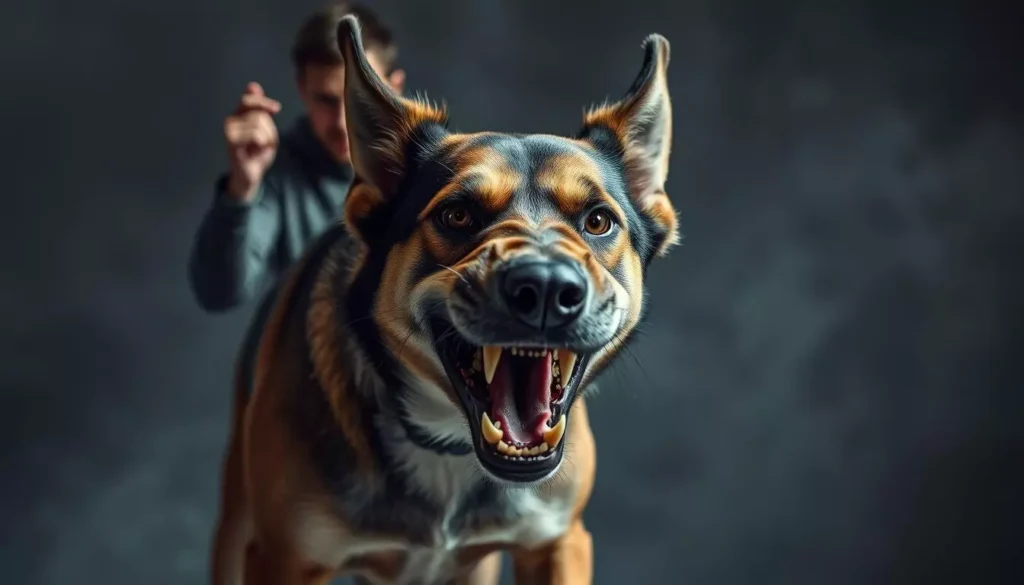
| Type of Aggression | Trigger | Behavior Characteristics |
|---|---|---|
| Territorial Aggression | Intruders near home | Barking, charging, growling |
| Protective Aggression | Threat to a loved one | Snapping, biting to guard |
| Possessive Aggression | Guarding valuable items | Growling, stiff body language |
| Fear Aggression | Feeling cornered or threatened | Snapping, fleeing, cowering |
| Defensive Aggression | Perceived threat | Growling, baring teeth |
| Social Aggression | Competition with other dogs | Excessive barking, growling |
Dog Aggressive to House Visitors: Understanding the Triggers
When my dog gets aggressive to visitors, it catches me off guard. Figuring out the triggers for dog aggression helps me feel better. Dogs often don't like new smells, sounds, or sights when strangers come in.
To make things better, I try to make visitors a positive thing. I give treats when they arrive if my dog stays calm. This teaches my dog that new people mean good things. I also introduce visitors slowly, letting my dog get used to them from afar.
Keeping things calm during visits helps my dog feel less stressed. This makes socializing easier. I also tell visitors about my dog's triggers. This helps them know how to act, making visits better for everyone.
| Trigger | Potential Reaction | Management Strategy |
|---|---|---|
| Unfamiliar scents | Barking or growling | Introduce visitors gradually, allowing smell exploration. |
| Unexpected noises | Hiding or snapping | Use calming sounds or play music to mask startling noises. |
| Strangers approaching | Chasing or lunging | Have visitors sit down initially to create a less threatening posture. |
Dealing with Aggressive Dogs: First Steps
Understanding aggressive dogs is key. The first steps to manage aggression involve identifying the type and cause. By observing my dog's triggers, I can create an effective plan.
Keeping a safe distance from triggers helps manage stress for both of us. Using calm and assertive body language is crucial. Yelling or sudden movements can make things worse.
Being a steady presence helps my dog feel secure. I avoid punishing aggressive behavior. Instead, I reward non-aggressive actions to build trust and encourage positive change.
Punishment can make aggression worse. Positive reinforcement is better. Rewarding my dog for good behavior helps us both. Keeping everyone safe is my top priority.
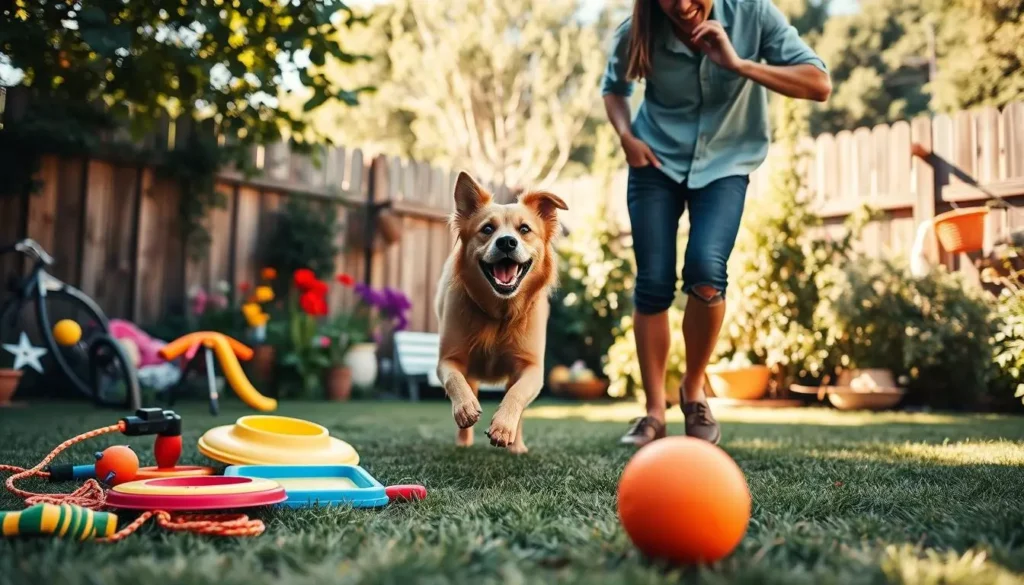
How to Handle Dog Aggression Towards Cats
Managing dog aggression towards cats needs careful thought. First, I figure out what makes my dog act out. Knowing these triggers is key to stopping aggression. I watch for signs of stress or situations that make things worse.
It's important to have separate spaces for my dog and cat. This makes them feel safe. I start by letting them meet briefly, with me watching. This helps manage their interactions.
Training can change how my dog sees my cat. I use counterconditioning, which is very helpful. I make my dog associate my cat with good things, like treats. Being consistent is crucial for lasting results.
Regular routines help change behavior. I'm patient and keep a close eye on them. This makes it more likely they'll get along.
| Approach | Description | Benefits |
|---|---|---|
| Identifying Triggers | Understanding what causes aggression in the dog. | Helps in creating tailored strategies for each pet. |
| Separate Spaces | Establishing different areas for the dog and cat. | Provides a safe environment for both pets. |
| Controlled Introductions | Gradually reintroducing the pets under supervision. | Lowers stress and builds trust over time. |
| Counterconditioning | Associating the cat with positive outcomes like treats. | Encourages a friendly demeanor towards the cat. |
| Consistency | Regular practice of training techniques. | Reinforces the behavior changes needed for peace. |
Training Strategies for Aggressive Dogs
Effective training strategies are key to tackling aggression in dogs. Positive reinforcement builds trust between the dog and its owner. This trust is the base for a better life together.
Positive Reinforcement Techniques
Positive reinforcement rewards good behavior. When my dog stays calm, I give them treats or praise. This teaches them that calmness is rewarded.
Desensitization and Counterconditioning
Desensitization slowly introduces my dog to triggers in a safe way. I reward them for staying calm. Counterconditioning changes how my dog feels about triggers, making them positive. Both need patience but work well.
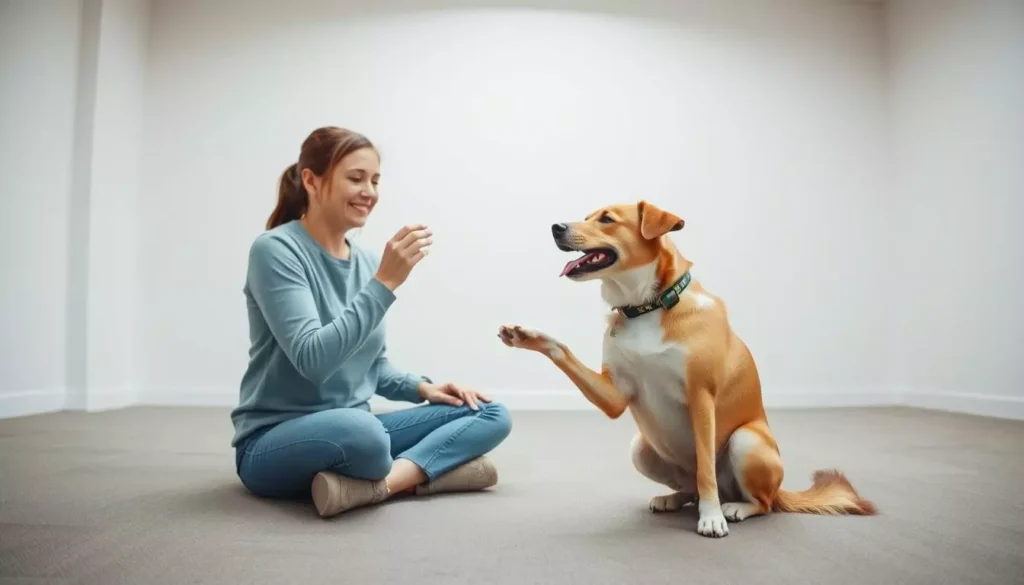
| Training Techniques | Description | Effectiveness |
|---|---|---|
| Positive Reinforcement | Rewarding desired behaviors to encourage calm responses. | High |
| Desensitization | Gradual exposure to triggers without provoking aggression. | Medium to High |
| Counterconditioning | Changing emotional responses to triggers through positive associations. | High |
Consulting a Professional: When to Seek Help
Dealing with aggressive dogs can be tough. When I face challenges that seem too much, I think about getting professional help. Knowing when to ask for a trainer's help is key. It can make a big difference between a safe situation and a dangerous one.
It's important to remember that some aggression might come from health issues. If that's the case, talking to a vet is a good first step. This not only helps my dog but also makes training more effective.
Finding a good dog trainer or animal behaviorist is crucial. They offer training plans that fit my dog's needs. These experts can help understand and fix the aggression problems.
Getting help early is important. The sooner I seek help, the better my dog's behavior will get. With the right advice, we can all be safer. Taking that first step is an investment in my dog's future.
Creating a Safe Environment for Your Dog
Keeping my dog safe is crucial, especially when they show aggressive behavior. I make sure they have a safe place to go when they feel scared or overwhelmed. This spot helps them calm down and lowers the chance of them getting aggressive.
Using baby gates or crates helps control who they meet. These barriers set clear limits, making my dog feel safe. It's also important to teach everyone in the house how to approach the dog gently. This helps avoid things that might make them angry.
By being proactive, I help create a peaceful home for my dog. A safe space isn't just about physical barriers. It's about making a place where my dog can feel safe and happy.
Preventive Measures to Reduce Aggression
Preventive measures for dog aggression are key for dog owners. Early socialization is very effective. It helps dogs become confident and adaptable.
Consistent training is also crucial. I use positive reinforcement to reward good behavior. This strengthens our bond and teaches my dog what's acceptable.
It's vital for dog owners to watch for early signs of aggression. Spotting subtle changes in behavior helps me act fast. If my dog seems uncomfortable, I address it right away.
Creating a positive environment is also important. I make sure my dog feels safe in different places. Managing stressors helps reduce aggression.
At times, getting professional help is a good idea. Trainers or behaviorists can create strategies that fit each dog's needs. This is a great way to prevent aggression.
Understanding Your Dog’s Teenage Phase Aggression
As I go through my dog's teenage years, I see that aggression is common. This stage is filled with hormonal changes and a need to find their place in the pack. My dog often acts out, wanting to be in charge, which leads to more aggression.
I remind myself that this behavior is just a phase, not a permanent trait. Knowing it's temporary helps me respond better. Keeping up with training and rewarding good behavior are key to handling teenage aggression.
Socialization is crucial during this time. I try to introduce my dog to different places and dogs to build positive experiences. These experiences help prevent long-term aggression and boost my dog's confidence.
In short, understanding that aggression in teenagers is normal helps me manage it better. By focusing on training, socialization, and understanding, I can guide my dog through this challenging time.
Conclusion
Dealing with dog aggression needs a mix of understanding and training. This article has given you important insights and strategies. It helps you understand the signs of aggression in dogs and why they act that way.
Knowing the type of aggression your dog shows is key. Whether it's territorial or fear-based, each case needs a special approach. This is how you handle it effectively.
It's also important to be patient and consistent with training. Sometimes, getting professional help is necessary. This can guide you through tough times.
By learning about dog behavior and taking preventive steps, we can make our homes safer. This is good for our dogs and everyone around them.
Being dedicated to behavior modification and support can really help. It makes our relationship with our dogs better. This leads to a peaceful living environment for everyone.

